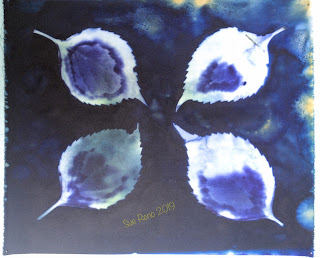This batch of prints was done mid-September, on cotton sateen that I treated with the cyanotype chemicals. At top are some hydrangea leaves, followed by a peony stem.
After laying leaves on the treated fabric, I sprayed them with water, covered them with glass, and set the out to expose in direct sunlight for about 6 hours. I didn't use any other chemicals or colors on them this time around. Above and below are some burdock leaves.
Here is a sprig of milkweed. Ordinarily I would not disturb milkweed, as it's an important plant for insect life, but this one was growing up in a neglected part of the garden, and had to go so I could clean up some shrubbery.
Here are the prints after exposure but before being rinsed. The more tender parts of the hydrangea let some light through in the long, bright exposure.
I've learned from experience that those lovely greenish tones will disappear with the rinse-out, so it's good to capture them in this stage.The burdock leaves have a nice halo effect going on.
On the milkweed print, I got the ephemeral and highly desirable aurora effect.
Here are the finished prints. Nothing too exotic, but good solid interesting images.
The halos held up in the burdock prints.
The milkweed print is quite beautiful and fully justifies sacrificing the plant.
If you are new here, I've been working with cyanotype since 2002, and with the wet cyanotype process since the summer of 2017. All the wet cyan posts, of which this is number 43, where I document my experiments in detail, are available in reverse chronological order by clicking the "Wet Cyanotype" tab in the header bar, or by going here.
And a reminder that you can also follow along on your social media of choice:
Facebook page:http://www.facebook.com/suerenostudio
Twitter feed: http://twitter.com/suereno
Tumblr: http://suerenostudio.tumblr.com
Instagram: https://www.instagram.com/sue_reno_studio/















1 comment:
It's good to see your lovely work again, Sue. Trusting that this new setup is enjoyable for you to work in.
Post a Comment